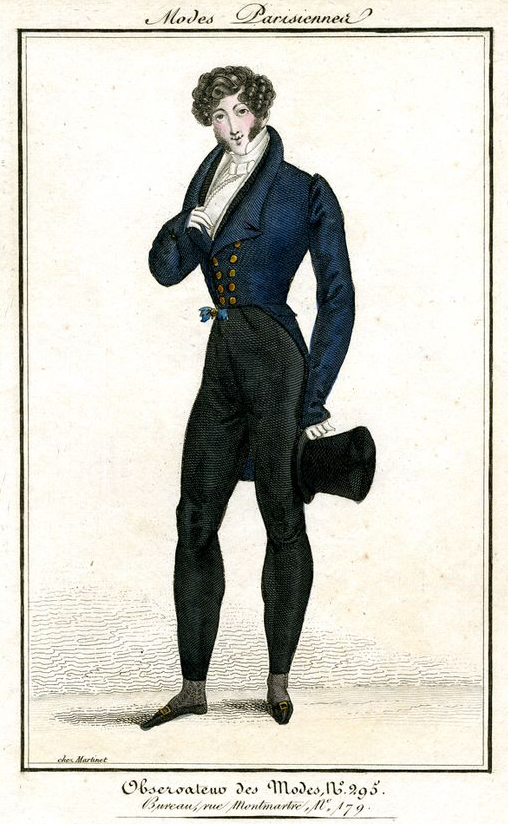
We agree with Barbey d’Aurevilly that dandyism is as difficult to describe as to define. We can opine about effortless elegance and sparkling wit, but dandyism is ultimately characterized by the nearly indescribable effect of the dandy’s appearance and demeanor on the spectator. The French call such effect a je ne sais quoi; in Hollywood, it’s called having “it.”
The magic of dandyism resides in the interplay between the dandy’s temperament and his appearance. Yet it is not a question of simple harmony, for one dandy may combine severe dress with a jocular demeanor, while another meshes cold aloofness with colorful and audacious dress. Nevertheless, what follows is an attempt to describe the indescribable, to unravel the formula of dandyism’s certain something. To do so we must bear in mind that dandyism is sometimes referred to as an affectation. In Regency England, dandyism became a fashionable pose when men wished to imitate Brummell without having either his sartorial originality or his particular temperament. And though Brummell surely exploited his temperament for effect in fashionable society, it was already present when he was a lad at Eton and distinguished himself by “the most bold and delicate mixture of impertinence and respect.”
The difference between the genuine dandy and the ersatz is shown explicitly in Stendhal’s The Red and the Black when Prince Korasoff says to Julien Sorel, “You have that natural froideur we try so hard to affect.” And so for those not born with a natural dandy effect, this dissection of the dandy temperament will serve as a guide to the proper pose.
Individual dandies throughout the ages have emphasized certain qualities over others, but all must be present in some degree for the effect to reach full fruition. And so here they are, ranked in order of importance:
1. Physical distinction
Dandyism can only be painted on a suitable canvas. It is impossible to cut a dandy figure without being tall, slender and handsome, or having at least one of those characteristics to a high degree while remaining at least average in the other two. Fred Astaire was neither tall nor handsome, but he was “so thin you could spit through him.”
Count D’Orsay, of course, had all three qualities to the highest degree.
“To appear well dressed, be skinny and tall.” — Mason Cooley
2. Elegance
Elegance, of course, as defined by the standards of a dandy’s particular era.
“[The dandy’s] independence, assurance, originality, self-control and refinement should all be visible in the cut of his clothes.” — Ellen Moers
Dandies must love contemporary costume, says Beerbohm, and their dress should be “free from folly or affectation.”
3. Self-mastery
Barbey speaks of the dandy’s staunch determination to remain unmoved, while Baudelaire says that should a dandy suffer pain, he will “keep smiling.”
“Manage yourself well and you may manage all the world.” — Bulwer-Lytton
“Immense calm with your heart pounding.” — Noel Coward
4. Aplomb
While self-mastery is the internal practice of keeping emotions in check, aplomb is how it is expressed to the dandy’s audience.
“Dandyism introduces antique calm among our modern agitations.” — Barbey d’Aurevilly
5. Independence
Ideally financial independence, but if the dandy is forced to work, a spirit of independence will be expressed through his work, as with Tom Wolfe. Independence — often to the point of aloofness — will also characterize the dandy’s dealings with the world.
“The epitome of selfish irresponsibility, he was ideally free of all human commitments that conflict with taste: passions, moralities, ambitions, politics or occupations.” — Moers
“Independence makes the dandy.” — Barbey d’Aurevilly
6. Wit
Especially a paradoxical way of talking lightly of the serious and seriously of the light that carries philosophical implications.
(See Oscar Wilde, his characters such as Lord Henry and Lord Goring, and to a lesser degree every other notable dandy.)
7. A skeptical, world-weary, sophisticated, bored or blasé demeanor
“The dandy is blasé, or feigns to be.” — Baudelaire
“A spirit of gay misanthropy, a cynical, depreciating view of society.” — Lister
8. A self-mocking and ultimately endearing egotism
“Other people are quite dreadful. The only possible society is oneself.” — Wilde, An Ideal Husband
9. Dignity/Reserve
Pelham, in Bulwer-Lytton’s novel, keeps the darker and stormier emotions to himself.
“A flawless dandy, he would be annoyed if he were considered romantic.” — Oscar Wilde, An Ideal Husband
10. Discriminating taste
“To resist whatever may be suitable for the vulgar but is improper for the dandy.” — Moers
11. A renaissance man
“A complete gentleman, who, according to Sir Fopling, ought to dress well, dance well, fence well, have a genius for love letters, and an agreeable voice for a chamber.” — Etherege, quoted by Bulwer-Lytton in Pelham
12. Caprice
Because dandies are an enigma wrapped in a labyrinth, and because dandyism makes its own rules, the final quality is the ability to negate all the others.
For in the end there is not a code of dandyism, as Barbey writes. “If there were, anybody could be a dandy.” — CHRISTIAN CHENSVOLD

The dandies are an enigma wrapped in a labyrinth, and because dandyish makes its own rules , the quality is the ability to negate all the others